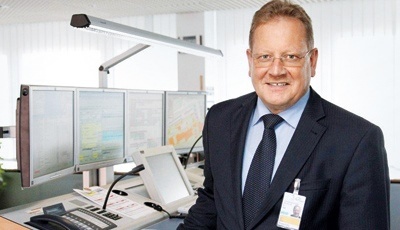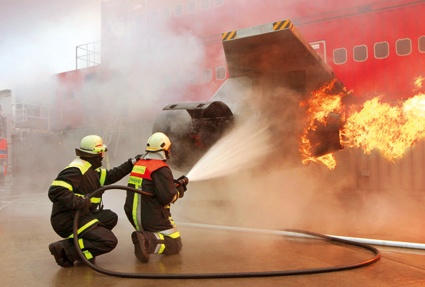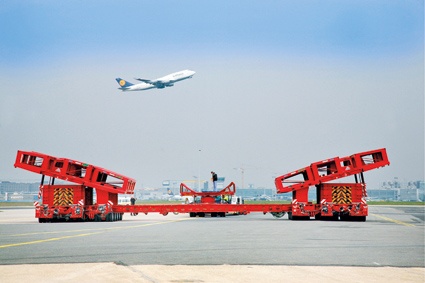Airport Security: Interview with Erich Keil, Head of Corporate Security Fraport AG
Internationally, Fraport belongs to one of the leading companies in the airport business and operates Frankfurt airport, one of the most important air transport hubs in the world. ...



Internationally, Fraport belongs to one of the leading companies in the airport business and operates Frankfurt airport, one of the most important air transport hubs in the world. The location employs some 78,000 people in the 500 or so companies and institutes (incl. The Squaire and Gateway Gardens), of which 21,000 alone work directly for Fraport. This makes Frankfurt airport the largest place of employment in Germany.
The Corporate Security team with a total of around 530 employees belongs to the Flight Operations and Terminal Management Division and has been led in this form since 2010 by Erich Keil. He heads the Security Control Room with its roles of Emergency and Continuity Management, Danger Prevention with preventative, defensive fire prevention (the airport‘s own fire team) and the Fire Brigade Training Center, Security Process and Contract Management with resource planning, Operative Management, the Investigation Group including person security, the Airport ID Service Center with responsibility for the regulation of air security training, the security infrastructure as well as Quality Management, the airport‘s own clinic and, last but not least, the Rescue Services.
He also represents Fraport AG in the Global Player Initiative, a dialog forum of the Bundeskriminalamt (Federal Office of Criminal Investigation), is a member of the Public Security Forum at the German Federal Parliament and belongs to the Security and Operations Technical Committee of the AdV (German airports working group). Our scientific Editor, Heiner Jerofsky, visited Erich Keil in his office and spoke with him about his responsibilities, challenges and security at the largest German airport.
GIT-SECURITY.com: You have been at Frankfurt airport since 1986 and, amongst others, were Chairman of the Board of the Fraport security subsidiary Frasec (Fraport Security Services). You have now been head of Corporate Security of Fraport AG for a number of years. What has changed during this time and which security and safety tasks form the main focus of your area of responsibility?
Erich Keil: In such a large organization such as Fraport there are of course continuous changes taking place, also in the area of safety and security. Starting from a purely operative function, the way things used to be done, we nowadays increasingly control the security processes to ensure high quality and efficiency. The operative activities on the other hand, insofar as they are not a core element of the tasks of an airport, are predominantly done by third parties. I‘m referring mainly to the checks of the staff of our company but also those of all other companies where their job necessarily takes them from the uncontrolled area to the controlled area for employees. That applies for the transitions within the terminals and also for apron access. Our 100% subsidiary FraSec should be mentioned here that provides this service for us together with the Airport Security Management division.
Flying and security are inseparably bound to one another. Every passenger and also every visitor expects the highest standards of staff, technology, maintenance and organization. How can you always meet these expectations?
Erich Keil: In Germany the aspects of airport security are divided into three distinct areas by law. The Bundesinnenministerium (BMI - Federal Ministry of the Interior) is responsible for passenger checks and has assigned the federal police the job of supervisory control. They themselves make use of mainly private security companies to carry out these control measures. The responsibility for security of the airport compounds lies with the airports themselves by law. This is supervised by the relevant regional aviation authority. And finally, responsible for security measures concerning air freight is the Bundesverkehrsministerium (Federal Ministry of Transport) that, as the responsible intermediate authority, has commissioned the Luftfahrtbundesamt (LBA - Federal Office of Civil Aviation) to carry out this task for them. It is most important that a uniform type of technology exists at all airports. The BMI ensures this in the first instance and has set up its own central research and test center at the state police in Lubeck. The capabilities of technical apparatus and processes are put to the test here and it is checked to see whether these can be integrated into the daily control procedures. Even if the European Commission declares certain technology as suitable, it will first of all be checked in Lubeck. If it is considered to be suitable there is will be employed by the state police and also the regional civil aviation authorities or the LBA 1 to 1.
The security control room is the ‚heart and brain‘ of your operations. What communication and visualization systems are used there primarily and how many call outs are there of Airport Security - including the fire brigade and the rescue services - each year, commanded, coordinated, monitored and documented by how many staff?
Erich Keil: The Security Control Room (SLS) is a so-called ‚integrated control room‘ in which all the activities of the security force, the airport fire brigade and the rescue services are coordinated. Of course, everything that happens in our SLS is documented, precisely and watertight. For this we use an operations control system for the documentation and also for the radio communication that has already been partially switched over to digital operation. Normal systems, such as mobile phones, are also used. And from all this we can derive statistics that I can happily quote to answer your question. The SLS also has access to the entire video surveillance at the airport, and that is a lot. Per shift there are around ten employees in the SLS. They are managed by Security Duty Officers (SDO) who direct not only internal staff but also the operative staff outside. In a 24 hour period there are usually around 650 to 800 events that result in about 500 to 600 jobs for Security, 70 to 80 jobs for the rescue services (including jobs for the so-called PRMs, the passengers with restricted mobility such as wheelchair passengers) and around 30 jobs for the fire brigade. The high number for Security results mainly from following up on air security alarms (e.g. securing of doors at the border of the controlled air side), fire and intrusion alarms and other security jobs. This is of course a massive number of events over the course of a year and you can appreciate the pressure under which the SDOs work together with the team in the SLS.
The airport‘s own fire brigade forms an important part of the whole security concept and has a broad range of responsibilities. What are its main tasks and how many personnel are involved?
Erich Keil: To carry out all the tasks there is a team of around 250 firemen and women on duty at the airport during the day and a large part of the night (325 including the administration, preventative fire protection and the fire brigade training center). The four fire stations within the compound are arranged so that any point on the extensive road and taxiway system can be reached within three minutes from receiving the alarm. At the new northwest runway this is actually achieved within two minutes. The broad range of jobs of preventative fire protection extends from tackling fires on aircraft and aircraft fire protection on the apron through fire protection in all the buildings and areas of the airport compound to technical support and operating the fire brigade training center. This is a center that serves not only for the training purposes of our own fire brigade but can also be used by firemen and women from other brigades.
To secure the new runway, Fraport tested and installed a new fence system for the first time, a high-performance alarm fence made by a German company. What have been your experiences with this technology to date? How common are false alarms and does the system actually save monitoring and reaction staff?
Erich Keil: This new type of fence is a great investment from an operational point of view. Since it was put into operation almost exactly two years ago there has not been a single false alarm. This has meant that, while still being visually pleasing, we have been able to adapt our routine inspection tours to the new situation. The cost/performance ratio is therefore ideal even though the fence was more expensive at the outset and the system - based on quiescent current - naturally by far exceeds the requirements set by either the ICAO (International Civil Aviation Organization) or the regional authorities.
How can you provide consistent all-round protection for the entire compound, for the sensitive apron, the important building, aircraft, vehicles, technical systems, airfield lighting, transport routes, fuel storage and pipelines? And how important are the video management systems, danger alert systems and high-security access control systems?
Erich Keil: Your question covers almost all the technic systems of an international airport of course! It‘s not about securing everything within one all-embracing airport fence. I‘ve already touched on some of the methods in explaining the tasks of our control center. The total security for all eventualities that you mentioned doesn‘t exist in one system as such. It is rather a coordinated interaction of video technology, alarm systems, control measures for people, vehicles and deliveries to the transit points to the security sensitive or secured areas and the cooperation of all employees at the airport. Everyone has a security job to some extent that starts with avoiding operational dangers (e.g. driving at the appropriate speed on the apron or following procedures at the aircraft stands).
There is continuous building, modernization or expansion at Frankfurt airport. That demands additional and certainly not insignificant security measures. How do you achieve this and with what personnel and technical effort? Do you also employ external security service providers and mobile security systems?
Erich Keil: This question addresses another significant part of the security tasks of an airport. Within our own organization we have a division that is responsible for this subject and works in close cooperation with the planners and those doing the work. The processes are conceived from a security background and implemented in process instructions. The security assignment and operations are then coordinated by the SLS. The number of staff assigned corresponds to the scale of the building works. Yes, external companies are sometimes engaged for these tasks. And in these cases the systems mentioned previously (video, communication) play an important role.
The airport has meanwhile become a shopping and experience airport. There are vital systems, such as security control rooms, alarm systems, automatic sprinkler systems, fully automatic baggage transport systems, communications systems and emergency power supplies in the publicly accessible terminals. How does the security architecture look here?
Erich Keil: Naturally an airport operator must offer products to its passengers, visitors and staff, on the one hand to provide the fundamentals but on the other hand to make the airport more attractive so that as many people as possible fly from here and so that you can feel good in such an enormous environment. At the same time, we try to make the waiting time for transfer passengers - who make up more than half of the total number of people using the airport - as pleasant as possible and to set up ideal and sensible transfer routes. From the point of view of security, it must be observed that the facilities used by them are always freely accessible and that our obligation to transport security is fulfilled in all aspects. This becomes noticeable above all when a lot of people are within our terminals at the same time. Think of the demonstrations that have taken place every Monday since the northwest runway was put into operation, where just in the area of Terminal B West between 500 and 800 people are mingling with the flying public. Here we have to organize the cooperation between the respective offices of the City of Frankfurt, the regional and state police and our corporate security so that on the one hand the normal passenger traffic can continue without complications but on the other hand the demonstrators can exercise their constitutional right.
Fraport is obliged to secure the airport compound because of various national and international laws. What sort of system copes with tens of thousands of IDs - how do you keep constant track of fluctuations, external companies and visitors? What systems do you prefer to use in each area (magnetic cards, transponders, RFID or biometrics) and what experiences have you made with the newest access control technology?
Erich Keil: You‘ll understand that for security reasons I can‘t talk about all our systems. However, the subject of ID is one of the most difficult to master within an organization that not only has many of its own employees but also those of external service providers to cover. The earlier ID service is therefore being given a comprehensive overhaul and will result in the airport ID Service Center. That sounds casual at first but it is a process that must be carried out together with the employees. In addition, our ID administration system must be adapted almost daily to the current conditions, not just for reasons of the fluctuation of employees, to keep more than 75,000 IDs and around 20,000 driving permits up-to-date. Further, the latest technology demands a change in our airport ID cards. Where before a magnetic strip on the card was sufficient, for an interim period we need hybrid IDs that have the magnetic stripe on one side but simultaneously include modern RFID technology and can be used at our new readers. Here it is only necessary to hold the ID close to the reader to read the data from the RFID chip. This ensures that only those people can enter the area behind the reader who have the appropriate authority. The same goes for driver‘s permits that meanwhile can be used at multiple locations. But I haven‘t yet mentioned the well-known color distinction of our IDs that discriminates between those authorized for public areas, operational areas and the apron.
How does the dialog between member companies and authorities within the Global Player Initiative contribute to airport security?
Erich Keil: I am convinced that security can only be ensured in a globally networked world if those responsible openly discuss the risks. The good communication between internationally operating companies and the security agencies about subjects such as commercial crime, people smuggling, corruption or the prevention of terrorism is irreplaceable. For this reason we take part - together with almost 60 other German companies - in the Global Player Initiative of the Bundeskriminalamts. This initiative has built up a network between the participating companies and the BKA to distribute security-relevant information quickly if needed. We company representatives use this opportunity, for example, to keep ourselves informed about the security situation in foreign markets in which Fraport is active or would like to be active. The exchange serves not only our own travel security, location security for existing activities of Fraport abroad but also for prevention in areas that may be relevant for Fraport in future. The Initiative is therefore for both sides an organization from which everybody profits. It is a give and take on both sides and this is the only way such a cooperation can be successful.
What are your prime aims in the near future? Where do you expect technical innovations and changes or a re-think of security planning? Erich Keil: I mentioned at the start of the interview that there are always changes going on at an airport like ours in Frankfurt, also in the security philosophy. From this comes my highest priority to take control of these changes, to coordinate them and communicate them within the organization but also in the affected departments of the airport and to the appropriate authorities. Sometimes approvals are necessary from the authorities, sometimes processes must be adapted or altered for legal reasons or because of the physical situation. And so there is a constant flow in security and never standstill. This applies to the technology as well that is being constantly developed and researched, just as in the past. Think for example of body scanners or mass spectrometer methods used in passenger or staff controls or the subject of liquids for passengers that are undergoing constant change and are dependent on the progress of technology. Those are words that a few years ago were not ever used in conjunction control technology.
It is good to know that you take on your difficult job with exceptional professionalism and great flexibility. Many thanks for your time and the informative conversation.
Business Partner
Fraport AGFlughafen Frankfurt am Main
60547 Frankfurt
Germany
most read


Integrated and Futureproof: Traka’s Next Chapter
Interview with Stefni Oliver on Traka’s Vision for the Future

Is Your Venue Ready for Martyn’s Law?
Martyn’s Law demands stronger security by 2027. Is your venue prepared to protect and respond?

Machine & plant safety: The winners of category A at the GIT SECURITY AWARD 2026
GIT SECURITY AWARD 2026: Machine & plant safety - an overview of the most innovative solutions

Video security & video management: the winners of category C at the GIT SECURITY AWARD 2026
GIT SECURITY AWARD 2026: Video Security & Video Management - an overview of the most innovative solutions







